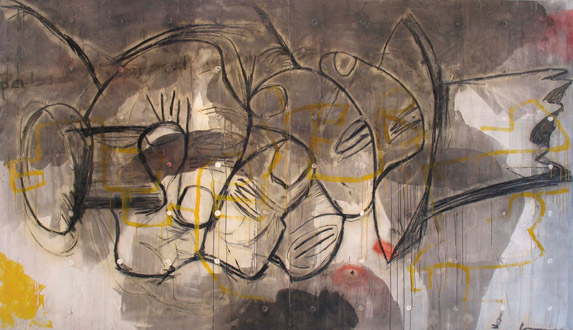Bryan Ryley: Sum of Destructions
Liz Wylie
Kelowna Art Gallery , November 7, 2009
essay for the exhibition
 Okanagan Valley-based artist Bryan Ryley has produced paintings, works on paper, and even at times sculpture, over a three-decade career now. Trained and formed in New York of the 70s, Ryley started out steeped in high modernism, which still forms much of the conceptual basis of his work, but his practice is by no means limited by that. Okanagan Valley-based artist Bryan Ryley has produced paintings, works on paper, and even at times sculpture, over a three-decade career now. Trained and formed in New York of the 70s, Ryley started out steeped in high modernism, which still forms much of the conceptual basis of his work, but his practice is by no means limited by that.
He also brings in aspects of both Dada and postmodernism to his work, and continues to explore new directions in a restless, searching manner. The suite of works on paper and attendant large painting on canvas in this small show were all created in 2004. Ryley often works in individual series, readily moving on when an idea becomes resolved, or a new one has pressingly presented itself.

In 2004 Ryley saw a magazine reproduction of a preparatory sketch by Pablo Picasso for his famous painting, Guernica. He scanned it and had the bold black outlines of a hand grasping the handle of a broken sword output at a large scale onto sheets of good quality drawing paper. These formed the matrixes for his series of ten works on paper and the basis for the underlying drawing elements of the large painting.
Guernica, we may recall, was produced by Picasso in 1937 as a commission by the Spanish Republican Government to help bring the cause of the Spanish Civil War to international attention. It depicts the bombing of the Basque village of Guernica by Nationalist Forces, even though it was populated mostly by women and children at the time. Ryley was interested in creating his own visual commentaries and meditations on current wars and warring political regimes. The visceral power of the cartoon-like fist gripping the broken sword seemed an apt and promising vehicle to him. Symbolically it makes reference to the idea of defeat or capitulation, but seems to inherently also contain the feeling of protest, no matter how futile. In Picasso’s Guernica the image of the hand holding the sword is in the lower portion of the work, almost in the centre of the painting. The arm belongs to a supine (perhaps dead) man whose open mouth seems to be crying out. Over the arm holding the broken sword stands Picasso’s famous defiant, writhing horse. |